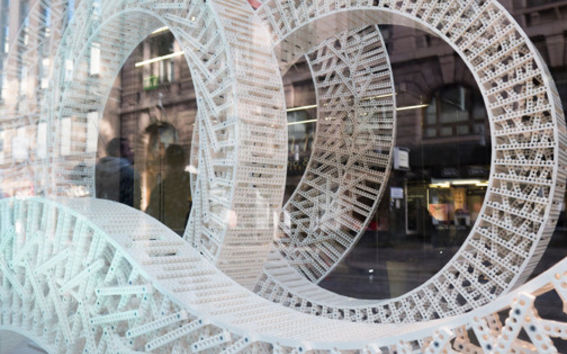Press Play combines architecture and algorithms into a live LEGO installation

The resulting work is large in size and combines different abstract architectonic elements; it is like a visual story that contains interesting details for people interested in architecture, art and technology. The work is a kinetic installation that continues to delicately alter its shape throughout Helsinki Design Week.
The objective of the university's courses in algorithmic architecture is not just to learn to utilise new design methods but also to learn to actively understand them.
'It is difficult to imagine architecture today without the digital design tools that make work more efficient and reduce the number of mistakes. They also enable the realisation of ideas that before would have been too complex or too expensive to be implemented,' explains lecturer Kai Salmi.
Multidisciplinary cooperation advances the design of computers
Press Play is continuation for the cooperation between LEGO Group and the Department of Architecture. In a Kinetic/Static pilot course that culminated in spring 2013, students were asked to produce algorithms the functioning of which they would understand thoroughly. As a final result, the students let the algorithms create vast, tower-like structures that they would then build from LEGO bricks.
'LEGO bricks, generally thought of as toys, are a feasible option when people require tools for fast-pace prototyping and problem-solving in complex design problems in architecture as well as in other fields,' says Irene Rissanen, Marketing Manager of LEGO Group in Finland.
Press Play adheres to Aalto University's central principle of creative cooperation that transcends boundaries. The work addresses a large number of challenges related to different fields, from structural durability to visual clarity. For this reason, students accepted for the course come from master's programmes in a wide range of disciplines: architecture, landscape architecture, new media, mechanical engineering and industrial design. The construction has been carried out in close cooperation with professionals in the field of lighting from the Aalto University Media Centre Lume and experts in robotics from the Department of Engineering Design and Production.
The Press Play installation is on show in the window display at the information point of Helsinki Design Week in the Kluuvi shopping centre at Aleksanterinkatu 9, starting from 4 September at 11 a.mm until 14 September. The information point is open from 11 a.m. to 7 p.m. on weekdays, from 11 a.m. to 5 p.m. on Saturdays and from noon to 5 p.m on Sundays. The installation is part of the programme for Helsinki Design Week, and it has been produced in cooperation with LEGO Group and the Aalto University Department of Architecture.
More pictures of the project in the Facebook album (facebook.com)
Further Information:
Lecturer Kai Salmi
tel. +358 44 011 5522
[email protected]
Read more news

DeployAI Partners Gather for Heart Beat Meeting in Helsinki
The European DeployAI project's partners gathered for the Heart Beat meeting hosted by Aalto University Executive Education in Helsinki.
In low-hierarchy organisations, even key policy issues are discussed in Slack
In a recent study, Aalto University alumn Lauri Pietinalho, a visiting scholar at New York University's Stern School of Business, and Frank Martela, an assistant professor at Aalto University, investigated how low-hierarchy organisations deal with shared policies in confrontational situations and how authority functions within them.
Getting bacteria into line
Physicists use magnetic fields to manipulate bacterial behaviour